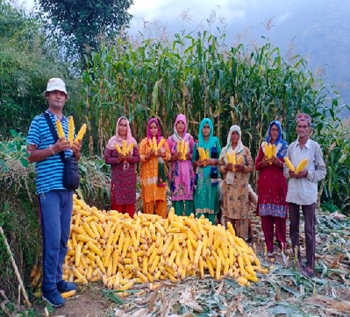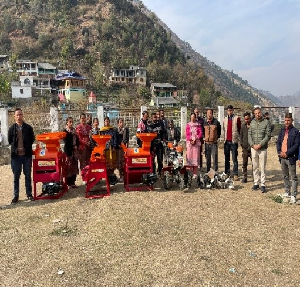ICAR–Indian Institute of Maize Research, Ludhiana, has spearheaded a quiet yet impactful transformation in Chamba one of Himachal Pradesh’s aspirational districts identified by NITI Aayog. In the hilly terrains of this region, where agriculture is largely dependent on traditional practices and manual labour due to limited accessibility to mechanization, maize cultivation has become a catalyst for change.

Maize is a major kharif crop in Chamba, cultivated on over 30,000 hectares, and is vital for both food and fodder security among the tribal communities. Recognizing the potential to bridge the gap between actual and attainable yields, ICAR-IIMR took on the challenge of introducing scientific maize farming practices, particularly in remote villages, to “reach the unreached.”
Between 2020 and 2025, under centrally sponsored schemes such as the Tribal Sub-Plan (TSP) and Scheduled Caste Sub-Plan (SCSP), ICAR-IIMR implemented targeted interventions in 16 villages including Bandla, Behi, Lakra, Kareri, Launa, Kira, Phagari, Morto, Chadi, Kolka, Rinda, Bainska, Rambho, Bhaijeera, Bhajlueing, and Dharveta aimed at improving livelihoods, enhancing productivity, and ensuring nutritional security.

Key Interventions:
• Equipment Support: Distribution of 18 corn threshers, 10 power tillers, MB ploughs, and spray pumps to tribal farmers.
• Seed Distribution: Introduction of short-duration, high-yielding hybrids LQMH 1 (QPM) and IMH 221 (SMH5).
• Capacity Building: Hands-on training on scientific cultivation, seed production, pest and disease management, and machinery operation in collaboration with the AICRP on Maize and CSKHPKV, Palampur.
Transformational Outcomes
• Yield Gains: Farmers achieved yields of 6.5–8.0 t/ha, with hybrids maturing 20 days earlier and producing 20–35% higher yields than traditional varieties.
• Mechanization Leap: Maize shelling time reduced from over a month to just one week with the introduction of threshers.
• Technology Adoption: Farmers began independently purchasing power tillers and adopting improved seed varieties.
• Nutritional Enhancement: The QPM hybrid doubled lysine and tryptophan content, improving the nutritional quality of maize-based diets.
• Timely Operations: Mechanization enabled timely land preparation and opened opportunities for sustainable intensification of maize-based systems.

Today, nearly every village involved in the program has farmers using power tillers, planting high-quality seeds, and applying improved crop management techniques. Over 600 farming families have directly benefited, with household incomes nearly doubling. The success is now spreading to neighbouring areas, creating a ripple effect of technology adoption.
This initiative by ICAR-IIMR has not only enhanced productivity and income but also reduced drudgery, ensured timely operations, and improved food and nutritional security. It stands as a model of science-led, farmer-first innovation in remote tribal hill regions, showcasing the power of technology convergence machinery, quality seeds, and farmer capacity building in driving sustainable agricultural transformation in the sub-Himalayan region of Chamba.
(Source: ICAR-Indian Institute of Maize Research, Ludhiana)
Video Link: https://www.youtube.com/watch?v=E-_ToI9yUTg&t=6s







फेसबुक पर लाइक करें
यूट्यूब पर सदस्यता लें
X पर फॉलो करना X
इंस्टाग्राम पर लाइक करें